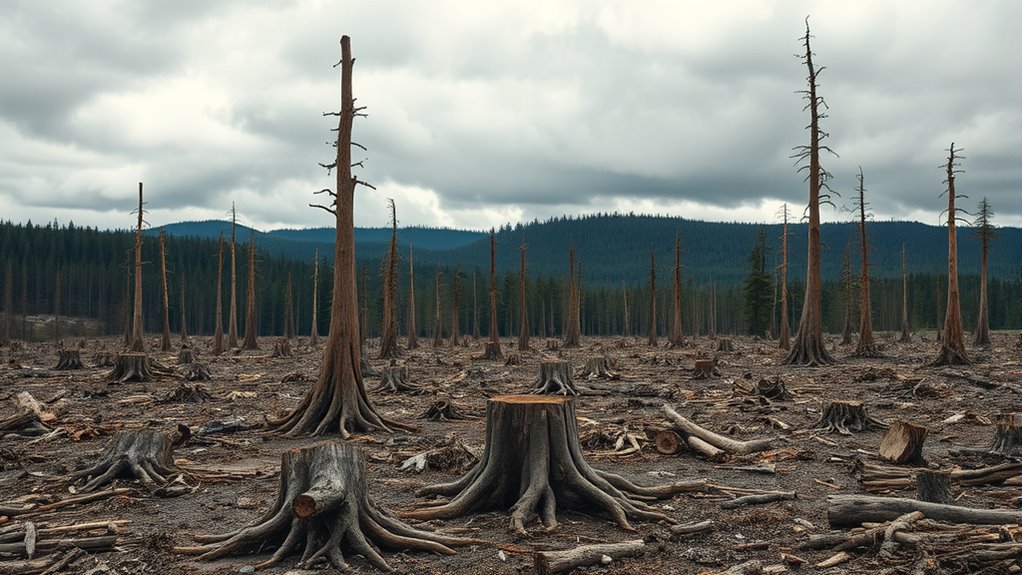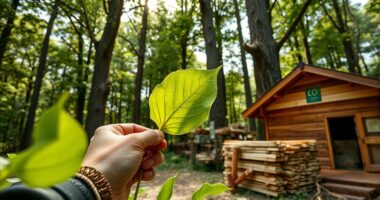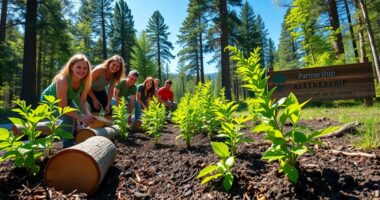Deforestation decreases the global supply of wood resources, directly impacting industries like construction, furniture, and paper. As forests are cleared for agriculture, logging, and urban expansion, natural wood stocks shrink, making quality timber scarcer. This leads to higher costs and increased pressure on plantations, which may lack biodiversity. Understanding how sustainable practices and conservation efforts can help protect wood availability is essential; there’s much more to discover about ensuring forest resources for the future.
Key Takeaways
- Deforestation reduces natural forests, decreasing the global supply of high-quality timber and wood resources.
- Unsustainable logging accelerates depletion, making it harder to meet rising wood demand for construction and industry.
- Forest loss diminishes biodiversity and ecological stability, impacting sustainable harvest and long-term wood availability.
- Increased reliance on plantations may not fully compensate for natural forest loss, risking environmental degradation.
- Conservation policies and sustainable management are essential to maintain wood resources amid ongoing deforestation.
Understanding Deforestation and Forest Degradation
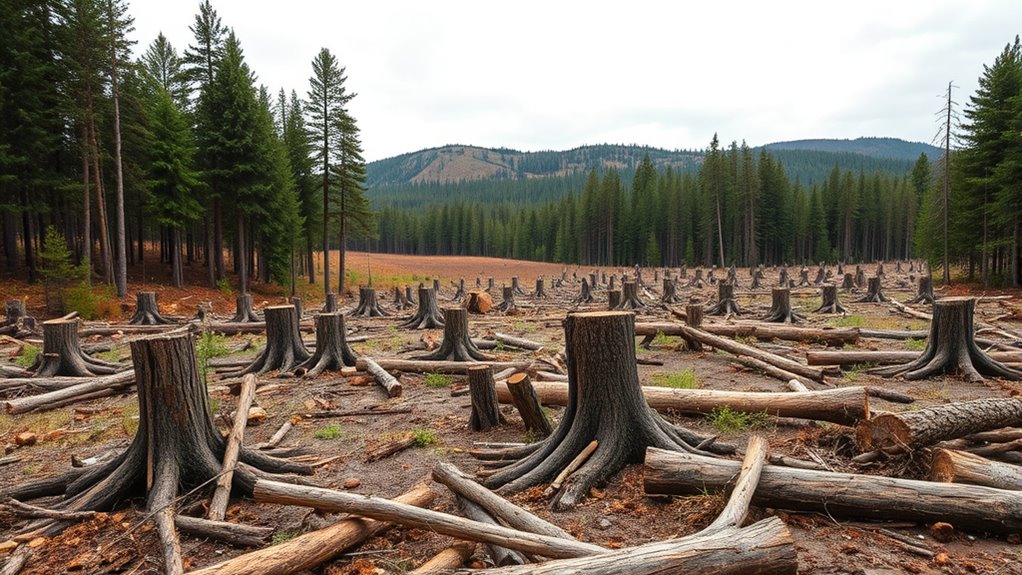
Understanding deforestation and forest degradation is essential because these processes directly threaten forest ecosystems and their resources. Deforestation involves human activities like land conversion, often driven by agriculture, illegal logging, mining, or infrastructure projects, which permanently remove forests and cause habitat loss. Forest degradation, on the other hand, involves activities like selective logging and thinning that weaken forest health without complete land clearing. Both reduce biodiversity, disrupt water cycles, and lower ecosystem stability. Tropical forests, such as the Amazon and Congo Basin, face especially high rates of deforestation, leading to decreased carbon storage and further climate impacts. Poor forest management exacerbates these issues, making it crucial to understand how both deforestation and degradation harm ecosystems and threaten the long-term availability of wood and other forest resources.
Key Regions Experiencing Forest Loss

You’ll notice that the Amazon rainforest has lost around 17% of its cover over the past five decades, mainly from cattle ranching and logging. The Congo Basin also faces significant forest loss, driven by agriculture and logging activities. These regions are critical to global biodiversity and wood resources, making their decline a pressing concern.
Amazon Rainforest Decline
The Amazon rainforest has undergone significant decline, with key regions like Brazil, Bolivia, and Peru bearing the brunt of deforestation. Over the past 50 years, about 20% of the forest has been lost, mainly due to land clearing for cattle ranching and soy farming. Deforestation rates surged nearly 60% between 2019 and 2022, driven by illegal logging and road expansion. This rapid forest loss releases billions of tons of carbon emissions, intensifying climate change and causing biodiversity decline. Most deforestation occurs within 3.5 miles of roads, fueling further land clearing and illegal activities. To combat this, better forest management and stricter controls on illegal logging are essential. Without action, the Amazon’s critical role in climate regulation continues to weaken. Additionally, integrating data-driven strategies can improve monitoring and enforcement efforts to curb illegal activities. Recognizing the importance of sustainable practices can also help preserve remaining forest areas and promote eco-friendly development. Implementing rigorous regulations and increasing transparency in land use can further aid conservation efforts. Promoting community engagement is vital for fostering sustainable conservation efforts that include local populations and indigenous groups.
Congo Basin Deforestation
As the second-largest rainforest in the world, the Congo Basin faces ongoing deforestation driven by illegal logging, mining, agricultural expansion, and infrastructure projects like roads and dams. Each year, about 1.1 million hectares of forest are lost, leading to significant forest cover reduction and habitat destruction. This deforestation threatens biodiversity and disrupts ecosystems indispensable for local communities. The region’s timber resources are impacted, reducing the availability of tropical hardwoods for global markets. Efforts in forest conservation and sustainable management are essential to curb illegal logging and promote forest health. Without such initiatives, continued forest loss in the Congo Basin will accelerate habitat destruction, diminish biodiversity, and undermine the long-term availability of wood resources critical for both local and international needs. Implementing sustainable forestry practices can help balance economic needs with environmental preservation. Additionally, promoting reforestation and afforestation projects can aid in restoring degraded areas and ensuring future timber supplies. Recognizing the importance of forest health is vital for maintaining the ecological balance and ensuring the sustainability of wood resources. Furthermore, fostering community engagement can enhance conservation efforts by involving local populations in sustainable forest management.
How Deforestation Affects Global Wood Supplies
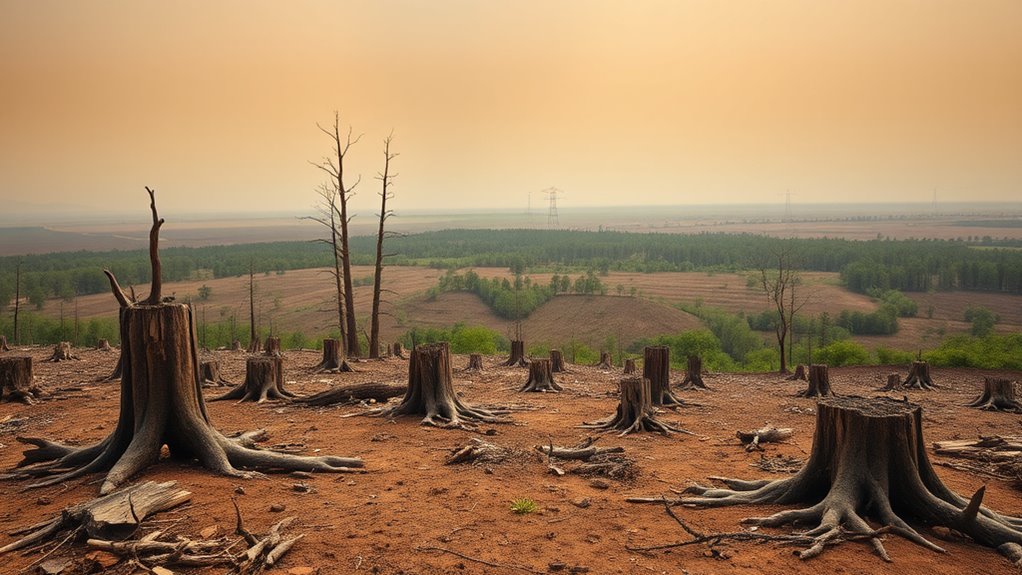
Deforestation directly decreases the amount of natural forest resources available worldwide, which in turn reduces the supply of timber needed for construction, furniture, and paper products. Each year, about 10 million hectares of forests are lost, markedly impacting global wood stocks. This forest loss results from converting natural forests into agriculture and urban areas, limiting high-quality wood sources. Unsustainable harvesting and illegal logging accelerate forest depletion, making it harder to meet the rising global wood demand. To compensate, plantations are expanding but often fall short due to limited biodiversity and ecological constraints.
Deforestation reduces global timber supplies, worsened by illegal logging and unsustainable harvesting practices.
- Reduced timber resources hinder construction and manufacturing.
- Illegal logging worsens forest depletion, decreasing sustainable wood supplies.
- Unsustainable harvesting challenges forest management efforts worldwide.
Main Causes Behind Forest Clearing
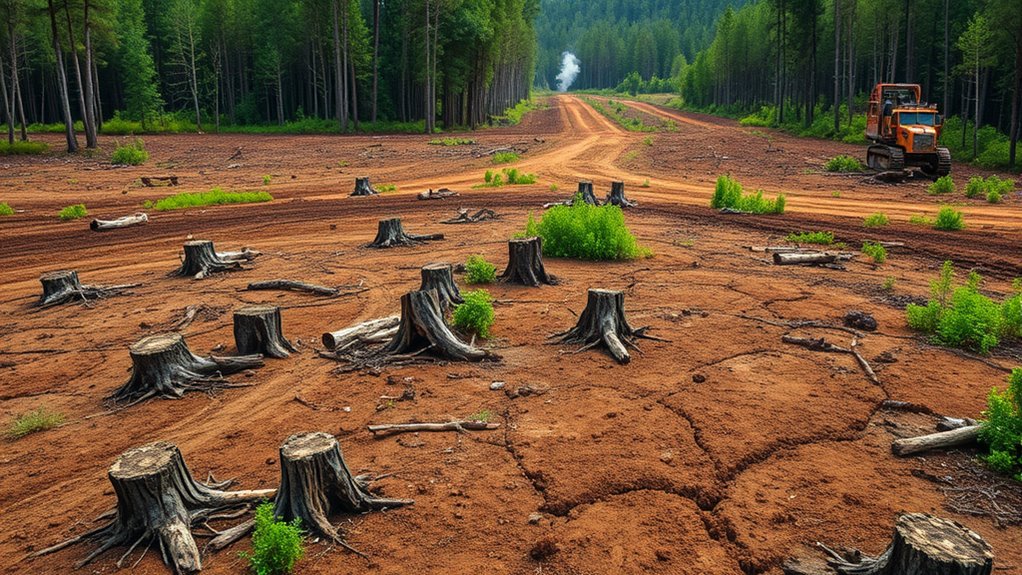
Agricultural expansion, particularly through cattle ranching and soy cultivation, stands out as a leading cause of forest clearing worldwide. This land clearing accelerates deforestation and habitat destruction, threatening biodiversity. Logging, both legal and illegal, also contributes heavily to forest loss, especially in tropical regions like the Amazon and Southeast Asia. Logging roads facilitate further land clearing and access to remote forests, fueling forest degradation. Infrastructure development, such as roads, dams, and urban expansion, opens forests to exploitation and accelerates habitat destruction. Mining activities for minerals like gold and coal cause significant land disturbance and deforestation in countries like Brazil, Ghana, and Indonesia. Additionally, climate change-induced wildfires are increasingly destroying forests, further supporting land degradation and forest loss. The role of merchant services in supporting sustainable supply chains is emerging as a way to encourage environmentally responsible practices. Promoting sustainable practices is essential to mitigate the ongoing impacts of deforestation and preserve vital ecosystems.
Environmental Consequences of Forest Loss

The removal of forests has far-reaching environmental effects that extend beyond local landscapes. Deforestation and forest loss considerably impact biodiversity, with about 137 species lost daily due to habitat destruction. You also face increased soil erosion and nutrient depletion, leading to landslides and reduced agricultural productivity. Additionally, forest destruction disrupts the water cycle by lowering transpiration and rainfall, causing droughts and altered river flows. These changes weaken ecosystem resilience, making areas more vulnerable to wildfires, floods, and climate extremes. Recognizing the importance of forest conservation is essential to addressing these environmental challenges and promoting sustainable solutions. Key consequences include:
- Elevated carbon emissions, fueling climate change
- Loss of natural resources critical for survival
- Decline in biodiversity and habitat stability
Economic Implications of Reduced Wood Resources

As natural wood resources diminish due to forest loss, industries like construction, furniture, and paper manufacturing face rising costs and shortages. Deforestation reduces wood resources, creating timber scarcity that drives up industry costs and hampers production. As forest depletion continues, market demand for plantation-grown wood increases, often leading to environmental degradation and social conflicts. The economic impact becomes clear with higher wood prices, which affect both consumers and businesses dependent on timber. Resource scarcity challenges global efforts to meet market demand and maintain sustainable forestry practices. Long-term shortages threaten industry stability, forcing companies to seek alternatives or face increased expenses. Ultimately, reduced wood resources due to deforestation disrupt economic stability and highlight the urgent need for sustainable management of forest resources. Additionally, the loss of natural forests also impacts essential ecosystem services, further threatening ecological balance and economic sustainability. This ongoing decline emphasizes the importance of sustainable forestry practices to mitigate long-term economic and environmental consequences.
The Role of Sustainable Forest Management
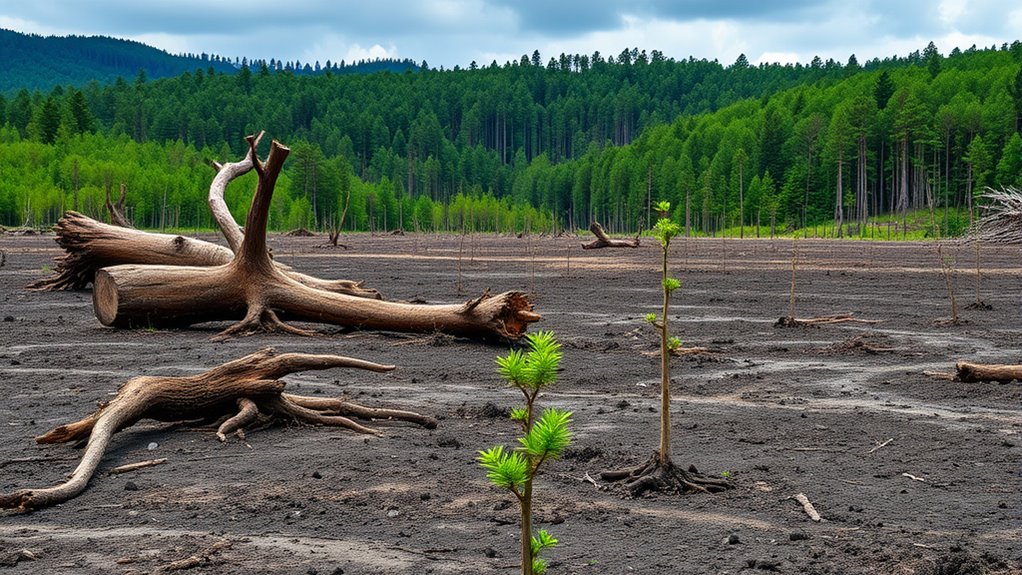
Sustainable forest management (SFM) plays a crucial role in guaranteeing that forest resources remain available for future generations while supporting ecological and social well-being. You can achieve this through responsible harvesting practices that prioritize biodiversity protection and ecosystem services. Certification systems like FSC and PEFC set standards for legal compliance and forest conservation, helping to guide sustainable practices.
Key aspects include:
Key aspects encompass promoting plantations, stakeholder engagement, and conserving biodiversity hotspots.
- Promoting plantation forests to boost forest productivity and reduce pressure on natural ecosystems
- Engaging stakeholders to ensure adaptive management and community support
- Maintaining forest carbon stocks and protecting biodiversity hotspots
Initiatives and Solutions for Forest Conservation
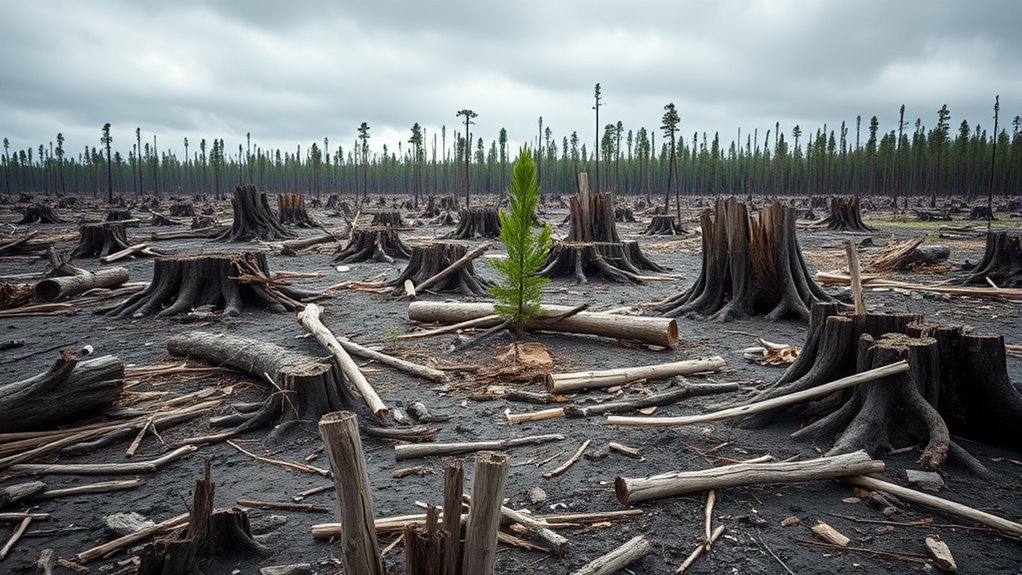
Efforts to conserve forests increasingly focus on implementing practical initiatives and solutions that balance economic needs with ecological health. Sustainable forestry practices, like responsible sourcing and forest management, are essential. Certification systems such as FSC ensure wood comes from well-managed forests, supporting biodiversity and reducing illegal logging. WWF initiatives promote reforestation and landscape restoration, crucial for healthy ecosystems and future wood supplies. Policies like the US Lacey Act combat illegal deforestation and illegal logging, reinforcing legal trade. Conservation programs and tools like the Wood Risk Tool help assess risks and promote sustainable practices. Here’s a quick overview: sustainable forestry practices.
By integrating advanced monitoring technologies, these initiatives can be more effectively implemented and monitored to ensure long-term success. Additionally, fostering community engagement ensures local stakeholders are invested in conservation efforts, leading to more sustainable outcomes. Incorporating innovative strategies can further enhance conservation effectiveness and encourage broader participation. Utilizing technological innovations can significantly improve the accuracy and efficiency of forest monitoring and management.
Ways Consumers Can Support Responsible Wood Use
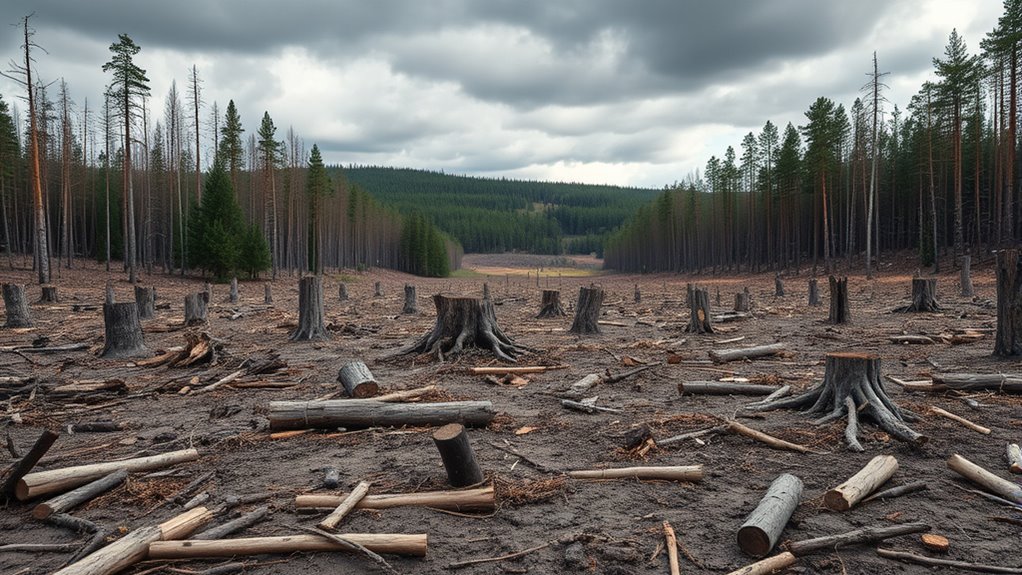
You can support responsible wood use by choosing FSC-certified products, which promote sustainable forest management and biodiversity. Supporting companies that source wood transparently helps prevent illegal logging and guarantees responsible harvesting. Using tools like WWF’s Wood Risk Tool allows you to verify product origins and avoid high-risk or uncertified sources. Incorporating sustainable practices can also foster a deeper appreciation for natural resources and promote environmentally conscious choices. Engaging with programs that encourage community-based forest management ensures that local stakeholders have a say in resource utilization and conservation efforts. Educating yourself about deforestation impacts can further motivate responsible consumption and conservation efforts.
Sustainable Product Choices
Choosing products made from responsibly sourced wood is one of the most effective ways to support sustainable forestry. By selecting FSC-certified forest products, you ensure the wood comes from well-managed forests that minimize environmental and social harm. Supporting companies that prioritize responsible sourcing promotes supply chain transparency and helps combat illegal logging. To reduce your environmental impact, consider options like recycled or reclaimed wood, which lowers demand for virgin timber. You can also choose plantation wood or bamboo as sustainable alternatives. Additionally, staying informed with tools like WWF’s Wood Risk Tool helps you identify high-risk or illegally harvested wood. Supporting these practices encourages better forest management and protects natural forests, ensuring the availability of quality wood for future generations.
Supporting Certification Standards
Supporting certification standards like FSC and PEFC plays a crucial role in ensuring that wood products come from responsibly managed forests. These certification standards set strict criteria for sustainable forests, promoting responsible sourcing and forest management practices that protect biodiversity and combat illegal logging. When you see eco-labels such as FSC, you can verify that the wood is verified and sourced responsibly. Choosing certified wood products directly supports forest conservation and encourages transparent supply chains. This transparency holds companies accountable, reducing the risk of illegal timber entering the market. Additionally, initiatives like WWF’s Wood Risk Tool help you assess the risk of non-compliant wood in products, empowering you to make informed purchasing decisions. Supporting these standards ultimately helps preserve our forests for future generations.
Frequently Asked Questions
Where Does the Wood From Deforestation Go?
You wonder where the wood from deforestation ends up. It often gets exported illegally or unsustainably, reaching global markets for construction, furniture, and paper products. Much of the harvested timber is processed into plywood, sawn timber, and panels before distribution. Some comes from local logging, while illegal sources cross borders, fueling demand worldwide. Certified, responsibly sourced wood is growing but still represents a smaller share of the market.
How Does Deforestation Affect Forestry?
You might wonder how forestry changes when forests are cleared. Deforestation diminishes natural timber sources, reducing the availability of high-quality wood. It also hampers forest regeneration, making it harder to sustain long-term wood supplies. As a result, you’ll find increased reliance on plantations or imports, which can strain global resources. Overall, deforestation impacts forestry by disrupting ecosystems and threatening future wood production, emphasizing the need for sustainable practices.
What Are the Environmental Impacts of Cutting Down a Forest to Obtain Wood?
When you cut down a forest to get wood, you cause significant environmental impacts. You release stored carbon dioxide, which worsens climate change. You also disturb water cycles, leading to droughts and flooding. Additionally, you destroy habitats, endangering wildlife and reducing biodiversity. Soil erosion and nutrient loss make land less fertile, while increased wildfire risks threaten ecosystems. Overall, your actions harm the environment and weaken the balance of nature.
What Is Responsible for 80% of Deforestation?
You might be surprised to learn that about 80% of deforestation is caused by agricultural expansion. This includes activities like cattle ranching, growing soy, and planting palm oil. These practices clear large areas of forest to meet global food and product demands. You should understand that this widespread land conversion markedly harms ecosystems, reduces biodiversity, and accelerates climate change. So, your choices can help reduce this impactful deforestation.
Conclusion
Remember, a tree is worth more alive than cut down. By supporting sustainable forestry practices and making conscious choices, you can help preserve our wood resources for future generations. Every small action counts—choose responsibly, advocate for conservation, and stay informed. When it comes to protecting forests, don’t wait until it’s too late. After all, as they say, “The best time to plant a tree was 20 years ago; the second best time is now.”
